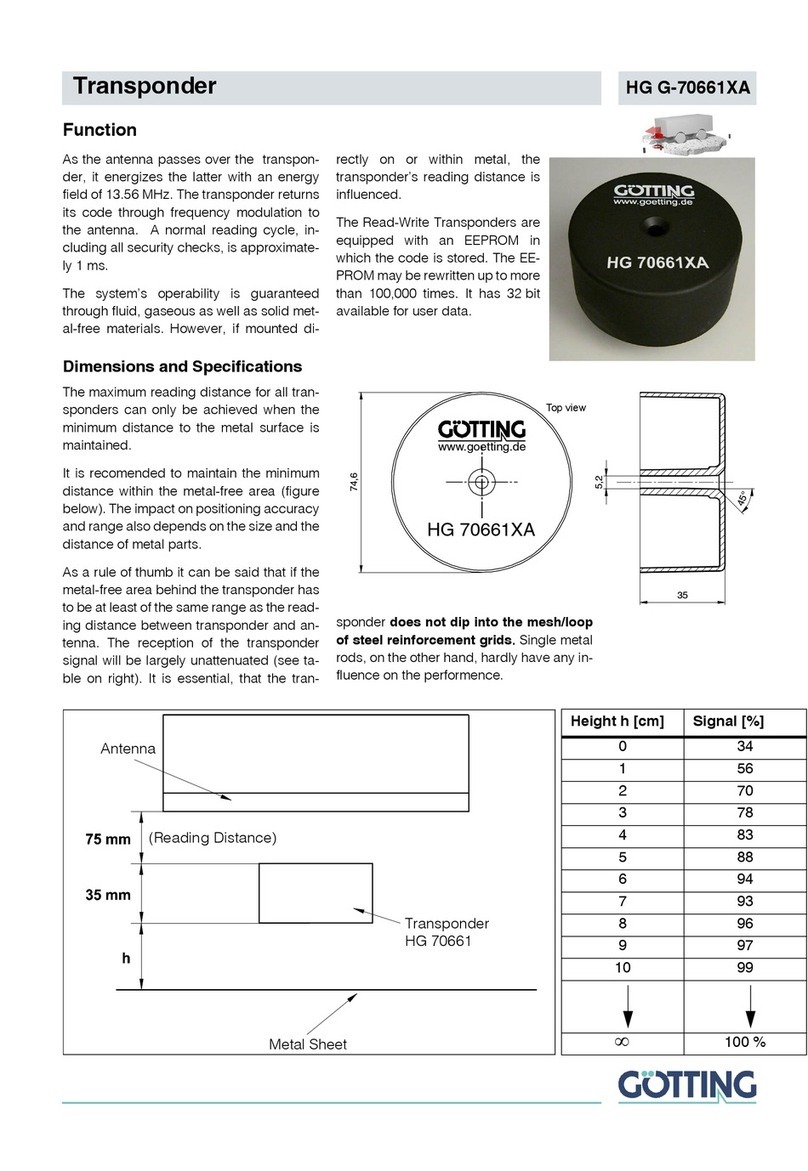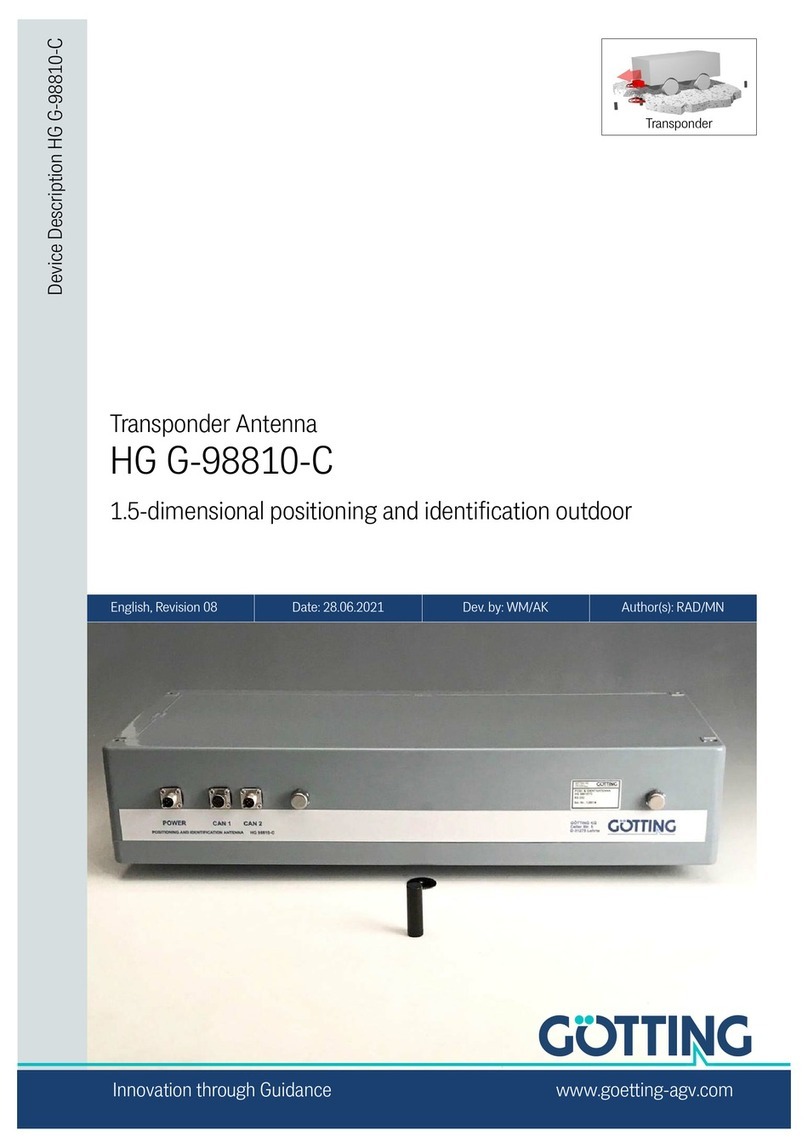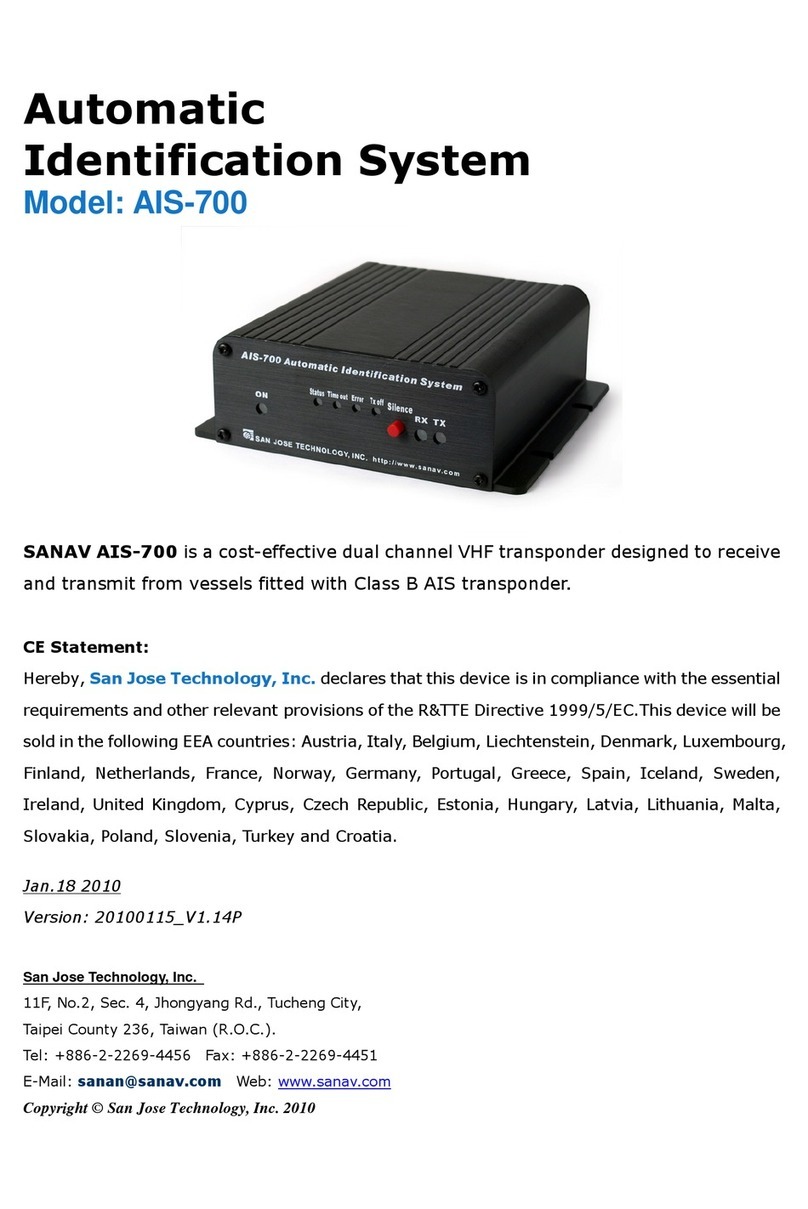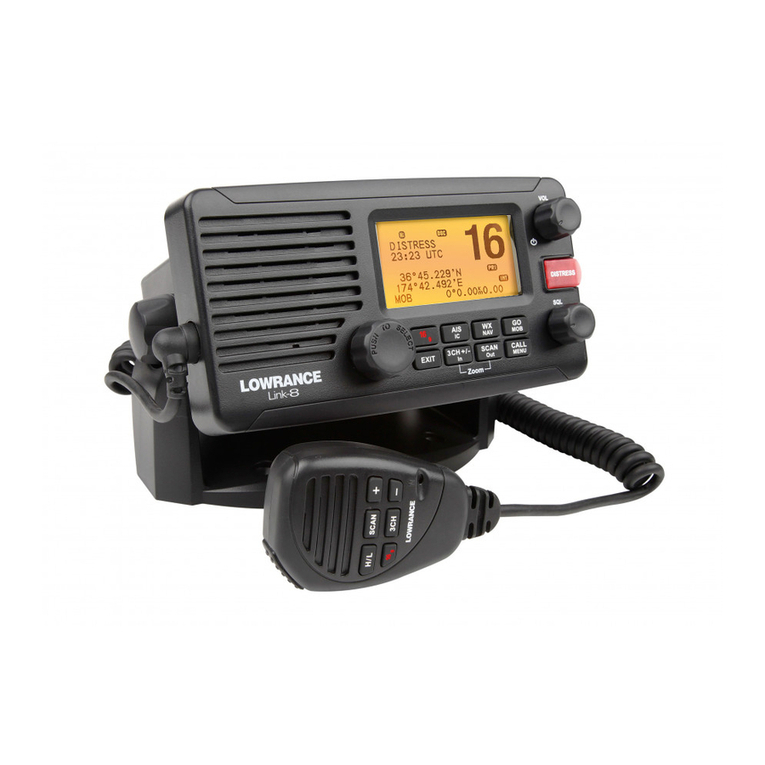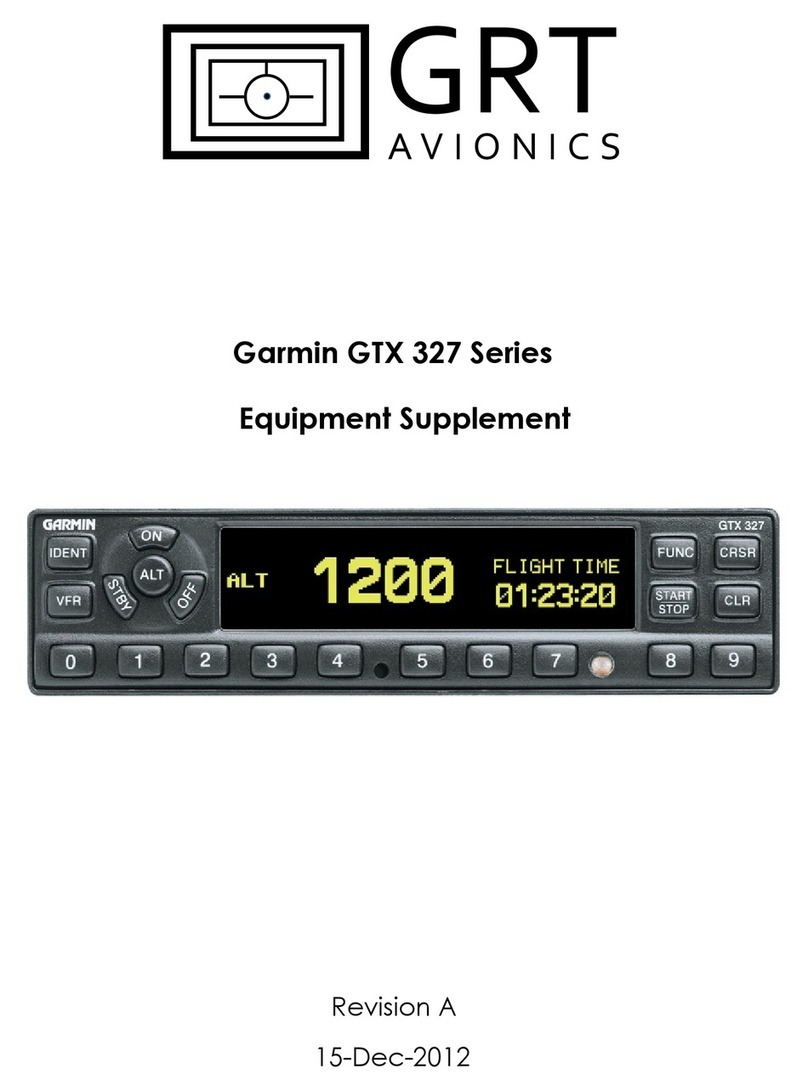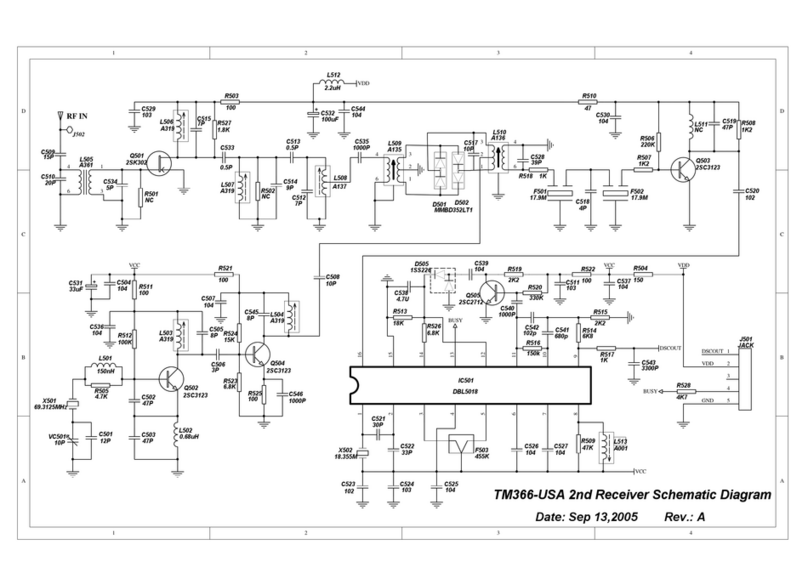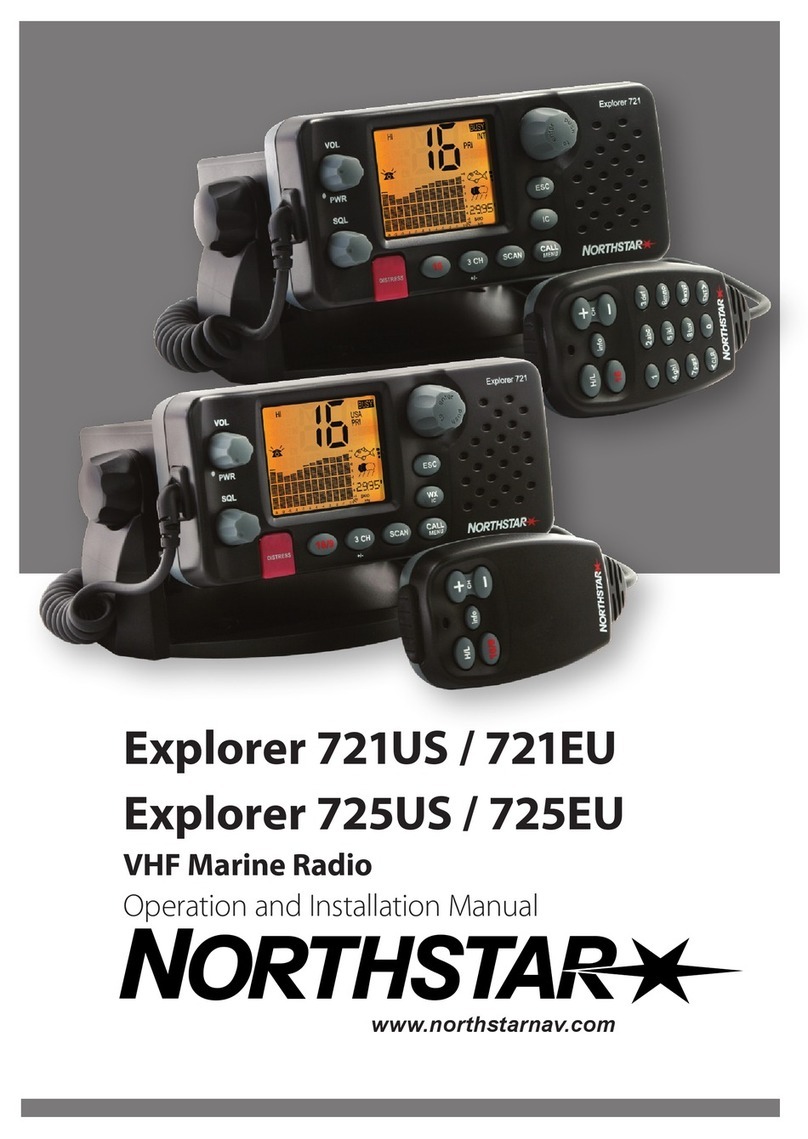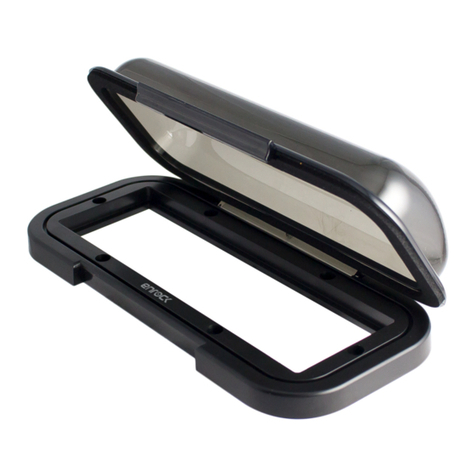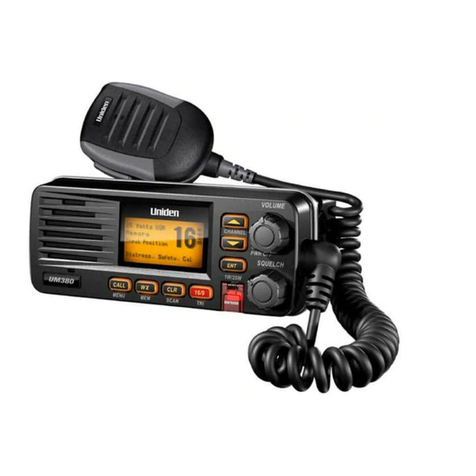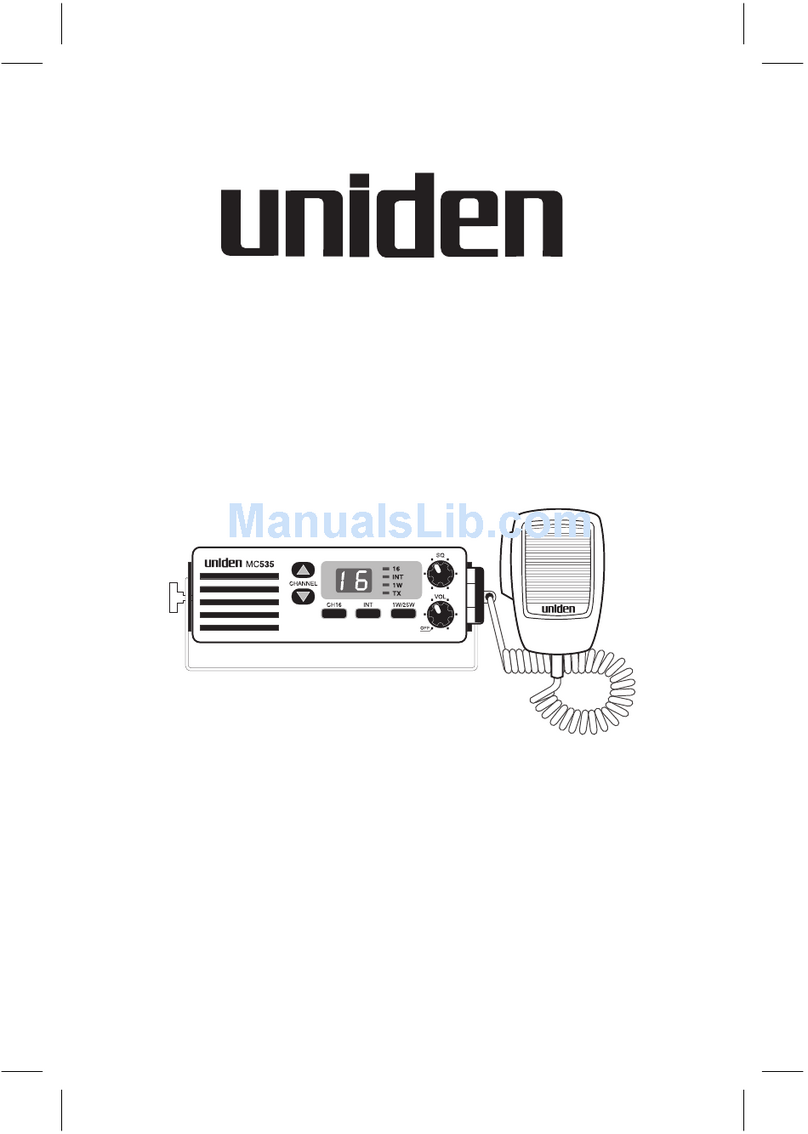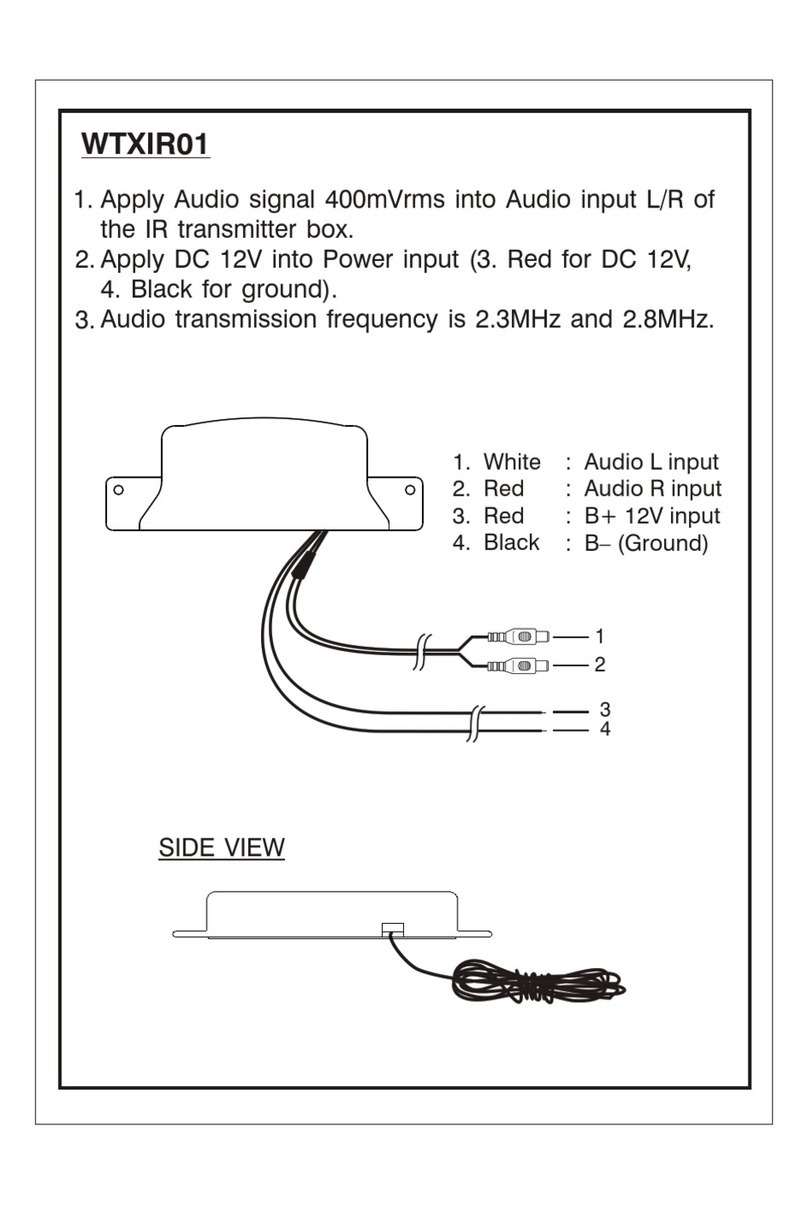Gotting HG G-71450-A User manual

Photo: Variant
HG G-71455ZA
Transponder-Antenna
HG G-71450/1/3/5-A
PosiPulse & Transponder-Code
Variants HG G-71450-A (RS232) / HG G-71451-A (Profibus) /
HG G-71453-A (CANopen®) / HG G-71455-A (Profinet)
English, Revision 02 Date: 06.06.2019 Dev. by: WM/LF Author(s): RAD/WM/LF/RF
Device Description HG G-71450/1/3/5-A
Transponder
Innovation through Guidance www.goetting-agv.com

Device Description HG G-71450/1/3/5-A | English, Revision 02 | Date: 06.06.2019
2Overview
Summary
Characteristics of the transponder antenna HG G-71450/1/3/5-A:
•Transponder-Antenna for the posi-
tioning of automated guided vehi-
cles (AGV)
•Indoor, IP 65
•Reading distance 50 mm
•max. crossing speed (depending on
variant and the functionality in use)
1.0 to 2.0 m/s
•Voltage supply (depending on the
variant) 22 - 28 VDC or 18 - 36 VDC,
current consumption typically
130 mA @ 24 VDC
•Operating frequency (depending on
the variant): 409 kHz, 125 kHz or
KATE 125 kHz
•Posipulse when crossing the center
axis in direction of travel, 24 V
20 mA current source
•Connectors (depending on the vari-
ant): Up to 3x M12
•Data interface (depending on the
variant): RS 232 (serial), Profibus,
CANopen®, Profinet (with inte-
grated switch)
•Service interface for configuration
and firmware update (depending on
the variant): serial RS 232 or USB
with USB virtual serial port driver
•Display operational state (depending
on the variant): Up to 5 LEDs
•Transponder programming
© 2019 Götting KG, errors and modifications reserved.
The Götting KG in D-31275 Lehrte has
a certified quality management system
according to ISO 9001.

Device Description HG G-71450/1/3/5-A | English, Revision 02 | Date: 06.06.2019
3
Table of Contents
Contents
1 About this Document........................................................................ 6
1.1 Warning Notices.................................................................................................................... 6
1.2 Symbols ................................................................................................................................... 7
1.3 Definitions of Terms............................................................................................................. 7
1.4 Abbreviations ......................................................................................................................... 8
2 Introduction....................................................................................... 9
2.1 Variants .................................................................................................................................... 9
2.2 Additional Products ............................................................................................................10
2.3 Additional Documents....................................................................................................... 11
2.4 Operating conditions .........................................................................................................11
2.5 Application Examples for the Automation .................................................................. 12
2.6 System Layout ..................................................................................................................... 12
2.7 Functional Description ......................................................................................................12
2.7.1 General Functional Description.................................................................................. 12
2.7.2 Scope and Function .......................................................................................................13
2.7.3 Signals and Timing......................................................................................................... 15
3 Hardware ......................................................................................... 16
3.1 Transponder .........................................................................................................................16
3.2 Transponder Antenna (Variants) .................................................................................... 16
3.2.1 Applies to all variants .................................................................................................... 16
3.2.1.1 Switch-on Behavior ...................................................................................................16
3.2.1.2 Code Output ................................................................................................................16
3.2.1.3 PosiPulse ......................................................................................................................16
3.2.2 Transponder Antenna HG G-71450 (RS 232) ........................................................ 17
3.2.2.1 Pin assignments .........................................................................................................17
3.2.2.2 LEDs ...............................................................................................................................18
3.2.2.3 Switch-on Behavior ...................................................................................................18
3.2.2.4 Code Output ................................................................................................................18
3.2.2.5 RS 232-Interface ........................................................................................................18
3.2.2.6 Serial/parallel Interface HG G-06150Y (optional).............................................18
3.2.3 Transponder Antenna HG G-71451-A (Profibus) .................................................. 18
3.2.3.1 Pin Assignments.........................................................................................................19
3.2.3.2 LEDs ...............................................................................................................................19
3.2.3.3 Switch-on Behaviour.................................................................................................20
3.2.3.4 Profibus-Interface ......................................................................................................20
3.2.3.5 RS 232-Interface ........................................................................................................20
3.2.4 Transponder Antenna HG G-71453-A (CANopen®).............................................20
3.2.4.1 Pin Assignments.........................................................................................................20
3.2.4.2 LEDs ...............................................................................................................................21
3.2.4.3 Data Interface CANopen® ....................................................................................... 21
3.2.4.4 RS 232-Interface ........................................................................................................21
3.2.4.5 PosiPulse Filter ...........................................................................................................21
3.2.5 Transponder Antenna HG G-71455-A (Profinet)...................................................22
3.2.5.1 Pin Assignments.........................................................................................................22
3.2.5.2 LEDs ...............................................................................................................................23
3.2.5.3 Data Interface Profinet ............................................................................................. 23
3.2.5.4 USB Interface .............................................................................................................. 23
4 Installation and Commissioning .................................................... 24
4.1 Testing Transponder ..........................................................................................................24
4.2 Installing Transponder ....................................................................................................... 24

Device Description HG G-71450/1/3/5-A | English, Revision 02 | Date: 06.06.2019
4Table of Contents
4.3 Transponder Antenna ........................................................................................................24
4.3.1 Mounting Holes ...............................................................................................................25
4.3.2 Connection Cable ...........................................................................................................25
4.4 Interface HG 06150Y (optional for HG G-71450) ......................................................26
4.5 Commissioning ....................................................................................................................27
5 Interfaces: RS 232/serial (HG G-71450) ........................................28
5.1 Interface Parameter RS 232 ............................................................................................28
5.2 Telegram Setup ASCII Coding (SW5 = ON) ................................................................29
5.3 Telegram Setup of Binary Coding (SW5 = OFF) ........................................................30
5.4 Resetting the Antenna.......................................................................................................30
5.5 Transponder Programming ..............................................................................................30
5.6 Serial/parallel interface HG G-06150Y (optional)......................................................31
6 Interfaces: Profibus (HG G-71451).................................................32
6.1 Profibus Address (Hex Rotary Switch) .........................................................................32
6.2 Profibus Configurations ....................................................................................................32
6.3 Status and Command Bits ...............................................................................................33
6.4 Transponder Programming ..............................................................................................33
6.5 GSD File .................................................................................................................................34
7 Interfaces: CANopen® (HG G-71453) ............................................35
7.1 Definitions CAN and CANopen® ....................................................................................35
7.2 Node ID ..................................................................................................................................37
7.3 Default Values ......................................................................................................................37
7.4 Description of the Transmission Process Data Objects (TPDO) ...........................37
7.5 Description of the Receiving Process Data Objects (RPDO) .................................38
7.6 Heartbeat ...............................................................................................................................38
7.7 Description of the Service Data Objects (SDOs) .......................................................39
7.8 Object Directory ..................................................................................................................39
7.9 Manufacture Parameters - Node parameters.............................................................45
7.10 Transponder Programming ..............................................................................................46
7.11 EDS File..................................................................................................................................46
8 Interfaces: Profinet (HG G-71455) .................................................47
8.1 Input Bytes ............................................................................................................................47
8.2 Output Bytes.........................................................................................................................47
8.3 Status bits .............................................................................................................................48
8.4 Instruction bits .....................................................................................................................48
8.5 Transponder Programming ..............................................................................................48
8.6 GSDML File ...........................................................................................................................48
9 Software / Configuration ................................................................49
9.1 Connection to a PC.............................................................................................................49
9.1.1 Via the serial interface (HG G-71450 / HG G-71451 / HG G-
71453) ................................................................................................................................49
9.1.2 Via the USB interface (HG G-71455) ........................................................................50
9.2 Terminal Program ...............................................................................................................51
9.3 Logging (CSV Output)........................................................................................................51
9.4 Monitor Program (Service) ...............................................................................................52
9.4.1 Main Menu Monitor Program HG G-71450.............................................................53
9.4.2 Main Menu Monitor Program HG G-71451.............................................................53
9.4.3 Monitor Program HG G-71453 ...................................................................................54
9.4.3.1 Main menu....................................................................................................................54
9.4.3.2 (P)osi Filter ...................................................................................................................54
9.4.3.3 CAN Menu.....................................................................................................................55
9.4.4 Main Menu Monitor Program HG G-71455.............................................................56
9.5 Update of the Operating Software (Firmware) ..........................................................57
9.5.1 About the RS 232 interface (HG G-71450 / HG G-71451 / HG
G-71453) ...........................................................................................................................57
9.5.2 Via the USB Interface (HG G-71455) ........................................................................58
10 Transponder Programming ............................................................61

Device Description HG G-71450/1/3/5-A | English, Revision 02 | Date: 06.06.2019
5
Table of Contents
10.1 Positioning of the Transponders using HG G-71325 as an example .................. 61
10.2 Programming via the Monitor Program ....................................................................... 62
10.3 Programming via Interface Telegrams ......................................................................... 62
10.3.1 HG G-71450: Programming via Serial Telegrams ................................................ 62
10.3.1.1 Structure of the Telegram (Host -> Antenna).................................................... 63
10.3.1.2 Structure of the Telegram (Antenna -> Host / if Transponder is
not programmed) .......................................................................................................64
10.3.2 HG G-71451: Programming via Profibus Telegrams ........................................... 64
10.3.3 HG G-71453: Programming via CANopen® Telegrams ...................................... 64
10.3.4 HG G-71455: Programming via Profinet Telegrams ............................................ 64
11 Maintenance.................................................................................... 66
12 Troubleshooting .............................................................................. 67
13 Technical Data ................................................................................ 69
13.1 Transponder Antenna ........................................................................................................69
13.2 Parallel Converter ...............................................................................................................70
14 List of Figures ................................................................................. 71
15 List of Tables................................................................................... 72
16 Index ................................................................................................ 74
17 Copyright and Terms of Liability ................................................... 76
17.1 Copyright ...............................................................................................................................76
17.2 Exclusion of Liability .......................................................................................................... 76
17.3 Trade Marks and Company Names ............................................................................... 76

Device Description HG G-71450/1/3/5-A | English, Revision 02 | Date: 06.06.2019
6Chapter 1 – About this Document
1About this Document
For you to be able to use your product simply and safely this device description uses
consistent warning notices, symbols, terms and abbreviations. Those are described
in the following sections.
1.1 Warning Notices
In this device description warning notices appear before sequences of actions that
may lead to damage to persons or property. The listed actions for the danger preven-
tion have to be observed.
Warning notices have the following structure:
The warning symbol (warning triangle) indicates danger to life or risk of injury.
The signal word indicates the severity of the danger.
The paragraph kind or source of the danger names the kind or source of the
danger.
The paragraph consequences describes the consequences of not observing
the warning notice.
The paragraphs for danger prevention explain, how to avoid the danger.
The signal words have the following meanings:
SIGNAL WORD
Kind or source of the danger
Consequences
Danger prevention
Table 1 Hazard classification according to ANSI Z535.6-2006
Warning Symbol, Signal Word Meaning
DANGER
DANGER indicates a hazardous situation
which, if not avoided, will result in death or
serious injury.
WARNING
WARNING indicates a hazardous situation
which, if not avoided, could result in death or
serious injury.
CAUTION
CAUTION indicates a hazardous situation
which, if not avoided, could result in minor or
moderate injury.
NOTICE
NOTICE indicates property damage: The
product or the environment could be dam-
aged.

Device Description HG G-71450/1/3/5-A | English, Revision 02 | Date: 06.06.2019
7
About this Document – Chapter 1
1.2 Symbols
In this device description the following symbols and formatting are used:
If this information is ignored,
the product may not be operated in an optimal way.
Indicates one or more links to the Internet.
–www.goetting.de/xxx
–www.goetting.de/yyy
Indicates tips for easier
operation of the product.
The check mark lists a requirement.
The arrow shows an action step.
The indentation shows the result of an action or an action sequence.
Program texts and variables are indicated through the use of a fixed width
font.
Menu items and parameters are shown in cursive characters.
Whenever the pressing of letter keys is required for program entries, the
required etter eys are indicated as such (for most programs by Götting
small and capital letters are equally working).
1.3 Definitions of Terms
Transponder
RFID Tag (mark) in/on the ground or mounted on moving parts, which is inductively
supplied with energy by the antenna and then with this energy sends his code at half
the frequency.
Posipulse
Also called middle signal, short for position impulse. With the position impulse the
time of crossing the reference axis can be transmitted by telegrams without time lag.
Energy coil
Coil whose generated alternating magnetic field supplies the transponder with en-
ergy. For some antennas, the code emitted by the transponder is also received via
this coil.
Nibble
A nibble (rarely called nybble or nyble) is a amount of data containing four bits; it is
also called a half byte (source: Wikipedia). The transponder code comprises 16 bits,
i.e. four nibbles. Thus four hexadecimal code digits can be represented.

Device Description HG G-71450/1/3/5-A | English, Revision 02 | Date: 06.06.2019
8Chapter 1 – About this Document
1.4 Abbreviations
AGV Automated Guided Vehicle
RFID Radio-Frequency Identification
EDS Electronic Data Sheet, configuration file for CAN bus systems
GSD General Station Description, device master data for Profibus and
Profinet devices

Device Description HG G-71450/1/3/5-A | English, Revision 02 | Date: 06.06.2019
9
Introduction – Chapter 2
2Introduction
Data transmission between various objects (tool carriers, tools, vehicles, etc.) and
the control system is crucial for ensuring the operating procedure. Movable objects
must be identified and positioned quickly and reliably. Thereby identification sys-
tems offer a safe, easy to install and economical solution. They can be used to man-
age and monitor processes.
Such a system is suitable for almost all areas in which production and transportation
processes need to be automated. In order to implement this automation, incoming
data on transport route and destination, location and production status must be col-
lected and processed. Special advantages of the inductive identification system are
the millimeter-precise positioning, long rage identification and insensitivity to con-
tamination.
2.1 Variants
The transponder antenna is available in several versions.
Table 2 Variant overview
Features
Order-No.
HG G-71450 HG G-71451 HG G-71453 HG G-71455
ZA YA XA ZA YA ZA YA ZA YA
Operating frequency
[kHz]
409 125 125
KATE
409 125 409 125 409 125
max. crossing speed
code output only 2,0 m/s 1,5 m/s 2,0 m/s 1,5 m/s 2,0 m/s 1,5 m/s 2,0 m/s
max. crossing speed
code & PosiPulse 1,5 m/s 1,0 m/s 1,5 m/s 1,0 m/s 1,5 m/s 1,0 m/s 2,0 m/s
PosiPulse exit
Data interface RS 232 (serial) Profibus CANopen® Profinet
Data output Code Code & PosiPuls Code & PosiPuls Code & PosiPuls
Config port RS 232 RS 232 RS 232 USB
Logging (CSV)
Supply 22 to 28 VDC 18 to 36 VDC
Temporary deactiva-
tion of antennas (via CAN)
PosiPulse delete com-
mand v. data interface
Transponder
programming
Firmware version 2.14 1.13 1.13 1.01

Device Description HG G-71450/1/3/5-A | English, Revision 02 | Date: 06.06.2019
10 Chapter 2 – Introduction
2.2 Additional Products
The following products of Götting can be used with the transponder antenna (note
variants). Rod transponders are usually installed in the ground, disc transponders
usually on the ground. The rod transponders listed below have a slightly higher
transmission power than the disc transponders.
Table 3 Additional products (part 1 of 2)
Order-No. Description
Compatible with transponder antenna
HG G-71450 HG G-71451 HG G-71453 HG G-71455
ZA YA XA ZA YA ZA YA ZA YA
HW CAB00001
Plug ST1: cable PUR,
5 m with M12 elbow
socket, 5-pol., A-coded
HW CAB00002
Plug ST2: cable Profi-
bus PUR, 5m, M12 5-
pol. plug straight, B-
coded, open end
HW CON00003
Plug ST2: alternatively
Profibus terminating
resistor
HW CAB00003
Plug ST3: cable PUR
Profibus, 5m, M12 5-
pol. socket straight, B-
coded, open end
HW CON00055
Plug ST2: CAN termi-
nating resistor (Termi-
nator), M12 Plug 5-pol.,
A-coded
HW CAB00064
Plug ST3: cable CAN-
Bus, 10 m, with shield-
ing, M12 socket 5-pol.
straight, A-coded, open
end
HG G-71325YA Transponder (rod)
409 kHz
HG G-71325ZA Transponder (rod)
125 kHz
HW DEV00033 Transponder (disc)
125 kHz
HW DEV00034
Transponder (disc)
125 kHz, pre-pro-
grammed
HW DEV00127 Transponder KATE
(disc) 125 kHz
HW DEV00128
Transponder KATE
(disc) 125 kHz, pre-pro-
grammed
HW DEV00130X Transponder (flat disc)
125 kHz

Device Description HG G-71450/1/3/5-A | English, Revision 02 | Date: 06.06.2019
11
Introduction – Chapter 2
2.3 Additional Documents
Additional documents are sent upon request or available on our
website. The QR-Code on the right leads you to our homepage
www.goetting-agv.com. Below you will find links to the specific
product pages.
Transponder HG G-71325-A
http://www.goetting-agv.com/components/71325
Transponder HW DEV00033/00034
http://www.goetting-agv.com/components/00033
Transponder programming device HG G-81830-A
http://www.goetting-agv.com/components/81830
Connection box HG G-20960ZA
http://www.goetting-agv.com/components/20960
2.4 Operating conditions
The following requirements apply to the use of the transponder antenna:
As shown in figure 12 on page 26, the antenna can be installed upright or cross-
wise on the vehicle. The shielded rear side may not point towards the transpon-
der, see figure 11 on page 26
The antenna can be installed with its back directly on metal.
These can interfere with the antenna: Conductive materials, conductor loops
and reinforcements in the reading area of the antennas or near the transponder
(see transponder data sheet) as well as interfering signals from clocked drives
and their power supply cables must be avoided (see section 4.3 on page 24).
Between two transponder antennas there has to be a minimum distance of
1500 mm, see Table 2 on page 9.
Between two transponders there has to be a minimum distance of 500 mm.
There may always be at most one transponder within the reading area of the
antenna.
HW DEV00130U
Transponder (flat disc)
125 kHz, pre-pro-
grammed
HG G-81840ZA Transponder program-
ming device
HG G-06150YA Serial/parallel
Interface
HG G-20960ZA Connection box
M12-5-8-USB
Table 3 Additional products (part 2 of 2)
Order-No. Description
Compatible with transponder antenna
HG G-71450 HG G-71451 HG G-71453 HG G-71455
ZA YA XA ZA YA ZA YA ZA YA

Device Description HG G-71450/1/3/5-A | English, Revision 02 | Date: 06.06.2019
12 Chapter 2 – Introduction
When changing the direction of travel, incorrect PosiPulses can occur as a mat-
ter of the principle. Changes of direction should therefore be avoided in the sys-
tem or compensated in the evaluation. For this purpose a PosiPulse delete
command can be given via the data interface, for example. You can see which
variants support this in Table 2 on page 9.
2.5 Application Examples for the Automation
Automation can be performed for:
Warehousing / production lines / material flow control systems
Location determination of vehicles and containers
Identification of containers
Management of loading and unloading processes
Positioning of vehicles in production areas
Location determination for public transport
2.6 System Layout
The transponder antenna is usually mounted under a vehicle and connected to the
vehicle computer (e. g. a PLC), which evaluates the PosiPulse and the transponder
code. The corresponding transponders are installed in or on the floor. See the follow-
ing sections for the operating principle.
Figure 1 Block diagram system layout
2.7 Functional Description
2.7.1 General Functional Description
The transponder antenna is used in identification systems with positioning. It emits
the transponder code and a position impulse (PosiPulse) of 100 ms duration when
the transponder crosses the center of the antenna (see below). This enables the de-
tection of exactly defined positions.
Transponder
Antenna
Bus variant
Profibus® /
open® /CAN
Profinet®
RS resp. USB232 (configuration)
PosiPuls
(alternatively via
Bus interface)
RS 232
Further Bus
participants (optional)
Supply
voltage
Direction of travel
Computer
+–
Vehicle
Transponder
PLC
/ vehicle controller
Ground

Device Description HG G-71450/1/3/5-A | English, Revision 02 | Date: 06.06.2019
13
Introduction – Chapter 2
As soon as a transponder is within the reading area of the antenna, it is supplied in-
ductively with energy by the energy coil without contact and then cyclically sends
its code back to the antenna at half the transmission frequency. Otherwise, the tran-
sponder is completely passive and does not require a power supply or battery. Only
one transponder at a time is allowed in the reading area of the antenna.
The transponder code can be reprogrammed via the antenna for compatible read/
write transponders (see Table 3 on page 10).
If several antennas are expected to operate simultaneously, the necessary minimum
distance (see section 2.4 on page 11) must be observed.
For some antenna variants, individual antennas can temporarily be deactivated via
the data interface. This can be used, for example, if the antennas do not necessarily
have to be used at the same time e.g. if one is used to detect transponders in longi-
tudinal direction, while the other is used for transverse drive. Table 2 on page 9
shows which variants support the deactivation.
2.7.2 Scope and Function
The positioning occurs according to the field compensation method. Centrically to
the reading station the resulting field for the transponder is erased, resulting in the
data-free area D, which has a width of 25 to 30 mm at the nominal reading distance
S and in which no telegrams are displayed, see Figure 2 below.
The field strength of the alternating magnetic field decreases with increasing dis-
tance between transponder and reading antenna. The exchange of information is
therefore only possible within the detection areas 1 and 2 (Figure 2). Viewed from
above, the detective areas are limited by the field length L and the field width B, see
Figure 3.
Figure 2 Detection area 1 and 2, data-free area D and nominal reading distance S, side view
transponder antenna
transponder detection areas
area 1
area 2
track
data-free area
D

Device Description HG G-71450/1/3/5-A | English, Revision 02 | Date: 06.06.2019
14 Chapter 2 – Introduction
Figure 3 Detection areas, top view
Only a maximum of one transponder is allowed in the detection area of the antenna
at all times! The following image shows several transponders to explain the different
transponder positions.
Figure 4 Core area of the reading antenna with position impulse (top view)
The code of the transponder is read in both detection areas. For an additional Posi-
Pulse to be triggered, the transponder must first have moved through area 1. The
maximum lateral offset to the antenna center is determined by line C. In this case,
the PosiPulse is generated as soon as the transponder reaches the crossing to the
data-free area D. Since both detection areas have a curved course, the point at
which a PosiPulse is triggered shifts the further away the transponder is from the
centre of the antenna (line A) (center deviation). The absolute values are given in sec-
tion 13.1 on page 69.
direction of travel F
L
magnetic
line A
transponder
reading antenna
B
detection area
field lines
area 1
area 2
direction of travel F
L
line C
distance (Z)
line A
transponder
area 2
area 1
D
transponder
antenna
B
F
F
Trigger of the positioning pulse (depending on direction F and distance to line A)

Device Description HG G-71450/1/3/5-A | English, Revision 02 | Date: 06.06.2019
15
Introduction – Chapter 2
2.7.3 Signals and Timing
Figure 5 Signals and Timing
At first the data is „uncertain“ and the signal strength is still low (area 2). When ap-
proaching further the signals of the data become stronger and can be read com-
pletely. Finally, the inner detection area (area 1) is reached. Leaving the detection
area is detected by decreasing of the thresholds (3 and 4).
Crossing the field boundary triggers the PosiPulse (center signal). By passing
through the next detection areas (5 to 8) the data is read and displayed again. At the
field boundary at point 8 no center signal is triggered now. The centre signal is also
not set if the vehicle stops and drives back in the detection gab (4 and 5) after pass-
ing through points 1 to 4. The PosiPulse is only emitted again for this transponder if
in the meantime another transponder with new code has been read or – depending
on the variant, see Table 2 on page 9 – a PosiPulse delete command (= delete last
transponder code) has been sent via the data interface.
If a vehicle stops before the PosiPulse is triggered and changes direction, a „wrong“
center pulse is generated at position 1 or 8. These positions are not exactly definable.
The identification system should therefore only be used in systems without
change of direction.
If data errors are generated by interference signals in areas 2 and 3 (or 6 and 7), a
positioning impulse is generated at the appropriate, wrong position!
transponder antenna
transponder detection area
area 1
area 2
direction
antenna length
data-free area (detection gap)
Midpoint
Crossover
(positioning signal)
signal (CD)
level
NF
signals
and timing
(not scaled)
Zt = Midpoint pulse time (duty cycle of the PosiPuls) = 100 ms
Zt

Device Description HG G-71450/1/3/5-A | English, Revision 02 | Date: 06.06.2019
16 Chapter 3 – Hardware
3Hardware
3.1 Transponder
The Götting transponders listed in Table 3 on page 10 are used as reference marks
in the ground. The transponder code consists of 16 bits.
3.2 Transponder Antenna (Variants)
3.2.1 Applies to all variants
The antenna system is located in a 156.5 x 31 x 53 mm (L x D x H) housing made
out of PC (polycarbonate). Depending on the variant, the height including connec-
tors is max. 70 mm.
3.2.1.1 Switch-on Behavior
After applying the operating voltage, the positioning output is active for the duration
of the reset (approx. 500 ms). To check their function, all LEDs are switched on for
500 ms, respectively. After approx. 2 s the device is ready for operation.
3.2.1.2 Code Output
The code transmitted by the transponder consists of a sequence of 24 bits in which
16 bits are coded. These are output serially or – with the optional serial/parallel in-
terface (see below) – parallel. Transponders can also be programmed via the anten-
na and the telegrams of the serial interface (see chapter 10 on page 61).
3.2.1.3 PosiPulse
The transponder antenna provides an output for the PosiPulse via ST 1 in all variants.
The position impulse is triggered at center crossing of the antenna. Its duration is
100 ms. When activated, 24 V with a current limitation of 20 mA are switched on the
corresponding output (no potential separation). For the sequence of a transponder
crossing and the triggering of the PosiPulse see chapter 2.7.3 „Signals and Timing“
on page 15.
If, for example, a 24 V voltage output is desired, contact 2 can be connected to GND
via a resistor of 1 KOhm, as shown in the following picture.

Device Description HG G-71450/1/3/5-A | English, Revision 02 | Date: 06.06.2019
17
Hardware – Chapter 3
Figure 6 Connection options PosiPulse
3.2.2 Transponder Antenna HG G-71450 (RS 232)
The connection of the antenna occurs via a 5-pin cable. The ST 1 connector is a M12
circular connector (see Figure 7). An angular connector with connection cable is
available as an accessory (see Table 3 on page 10).
Figure 7 HG G-71450: Housing Dimensions Transponder Antenna
3.2.2.1 Pin assignments
Table 4 HG G-71450: Pin assignment of the 5 pin circular connector ST 1, male, A-coded
ST1, male, A-coded Pin Assignment
1 +UB
2 POSI out (20 mA)
3 TxD (RS 232) *)
4 RxD (RS 232) *)
5 GND (Data and supply)
*) The specifications TxD and RxD refer to the antenna.
Pin
HG G-7145x
2
5
Posi
Pulse
Posi
+24 VDC
GND
Connection to a Relais
Connection to a PLC
Pin
HG G-7145x
2
5
Posi
Pulse
Posi
+24 VDC
GND
SPS
ST 1
M12 x 1 circular connector
5-pin (male), A-coded
Position of the ferrite rod
156.5 mm
1
2
3
4
5

Device Description HG G-71450/1/3/5-A | English, Revision 02 | Date: 06.06.2019
18 Chapter 3 – Hardware
3.2.2.2 LEDs
4 LEDs are provided for function control:
3.2.2.3 Switch-on Behavior
After applying the operating voltage, the positioning output is active for the duration
of the reset (approx. 500 ms). To check their function, all LEDs are switched on for
500 ms. After approx. 2 s the device is ready for operation.
3.2.2.4 Code Output
The code transmitted by the transponder consists of a sequence of 24 bits in which
16 bits are coded. These are emitted serially or – with the optional serial/parallel in-
terface (see below) – parallel. Transponders can also be programmed via the anten-
na and the telegrams of the serial interface (see chapter 10 on page 61).
3.2.2.5 RS 232-Interface
For the telegrams of the RS 232 interface and the configuration of the interface pa-
rameters see chapter 5 on page 28.
3.2.2.6 Serial/parallel Interface HG G-06150Y (optional)
It is possible to convert the output from serial to parallel, see chapter 5.6 on page 31.
3.2.3 Transponder Antenna HG G-71451-A (Profibus)
The antenna is connected via a 5-pin cable. The connectors are M12 circular con-
nectors. Connection cable with M12 connectors or a Profibus terminating resistor
are available as accessories (see Table 3 on page 10).
Figure 8 HG G-71451: Housing Dimensions of the Transponder Antenna
Table 5 HG G-71450: Meaning of the 4 LEDs
LED Meaning
PWR Indicates that operating voltage is available
DATA is permanently lit when a transponder is in area 1 (see Figure 2 on
page 13)
CD –flickers when a transponder approaches (area 2 in Figure 2 on
page 13)
–is permanently lit when the transponder is read reliably
POS PosiPulse, corresponds to the positioning output
M12 x 1 circular connector
5 pin (female), B-coded
Position of the ferrite rod
156.5 mm
Profibus-Address
5 pin (male), B-coded
M12 x 1 circular connector
5 pin (male), A-coded
M12 x 1 circular connector

Device Description HG G-71450/1/3/5-A | English, Revision 02 | Date: 06.06.2019
19
Hardware – Chapter 3
3.2.3.1 Pin Assignments
3.2.3.2 LEDs
5 LEDs are provided for function control:
Table 6 HG G-71451: Pin assignment of the 5 pin circular connector ST1, male, A-coded
ST1, male, A-coded Pin Assignment
1 +UB
2 POSI out (20 mA)
3 TxD (RS 232) *)
4 RxD (RS 232) *)
5 GND (data and supply)
*) The specifications TxD and RxD refer to the antenna.
Table 7 HG G-71451: Pin assignment of the 5 pin circular connector ST2, female, B-coded
ST2, female, B-coded Pin Assignment
1 Bus +5 V
2 Bus A
3 RTS
4 Bus B
5 Bus GND
Table 8 HG G-71451: Pin assignment of the 5 pin circular connector ST3, male, B-coded
ST3, male, B-coded Pin Assignment
1 Bus +5 V
2 Bus A
3 RTS
4 Bus B
5 Bus GND
Table 9 HG G-71451: Meaning of the 5 LEDs
LED Meaning
PWR indicates that operating voltage is available
CD permanently lit when a transponder is in area I (see Figure 2 on
page 13)
DATA –flickers when a transponder approaches (area II in Figure 2 on
page 13)
–permanently lit when the transponder is read reliably
POS Corresponds to the positioning output
additional indicator function:
–Blinks once if an address >126 has been set
–Blinks 2 or 3 times for internal Profibus errors
BUS lit during data exchange with the Profibus master
1
2
3
4
5
12
3
4
5
21
4
3
5

Device Description HG G-71450/1/3/5-A | English, Revision 02 | Date: 06.06.2019
20 Chapter 3 – Hardware
3.2.3.3 Switch-on Behaviour
After applying the operating voltage, the positioning output is active for the duration
of the reset (approx. 500 ms). To check their function all LEDs except the BUS-LED
are switched on for 500 ms. After approx. 2 s the device is ready for operation.
3.2.3.4 Profibus-Interface
For this antenna the data as well as a status byte are transmitted via the Profibus.
Further information on the Profibus interface and on setting the Profibus address via
the Hex-turn-switch can be found in chapter 6 on page 32.
3.2.3.5 RS 232-Interface
The RS232 interface is used for logging and for the internal monitor program for
configuration, see chapter 9 on page 49.
3.2.4 Transponder Antenna HG G-71453-A (CANopen®)
The antenna is connected via a 5 pin cable. The connectors are M12 circular con-
nectors. Connection cables with M12 connectors or a CAN terminating resistor
(CAN Terminator) are available as accessories (see Table 3 on page 10).
Figure 9 HG G-71453: Housing Dimensions Transponder Antenna
3.2.4.1 Pin Assignments
Table 10 HG G-71453: Pin assignments of the 5 pin circular connector ST1 (pin)
ST1, male, A-coded Pin Assignment
1 +UB
2 POSI out (20 mA)
3 TxD (RS 232) *)
4 RxD (RS 232) *)
5 GND (data and supply)
*) The specifications TxD and RxD refer to the antenna.
M12 x 1 circular connector
5 pin (female), A-coded
Position of the ferrite rod
156.5 mm
CANopen® Node ID
5 pin (male), A-coded
M12 x 1 circular connector
5 pin (male), A-coded
M12 x 1 circular connector
1
2
3
4
5
Other manuals for HG G-71450-A
1
This manual suits for next models
3
Table of contents
Other Gotting Marine Radio manuals
Popular Marine Radio manuals by other brands
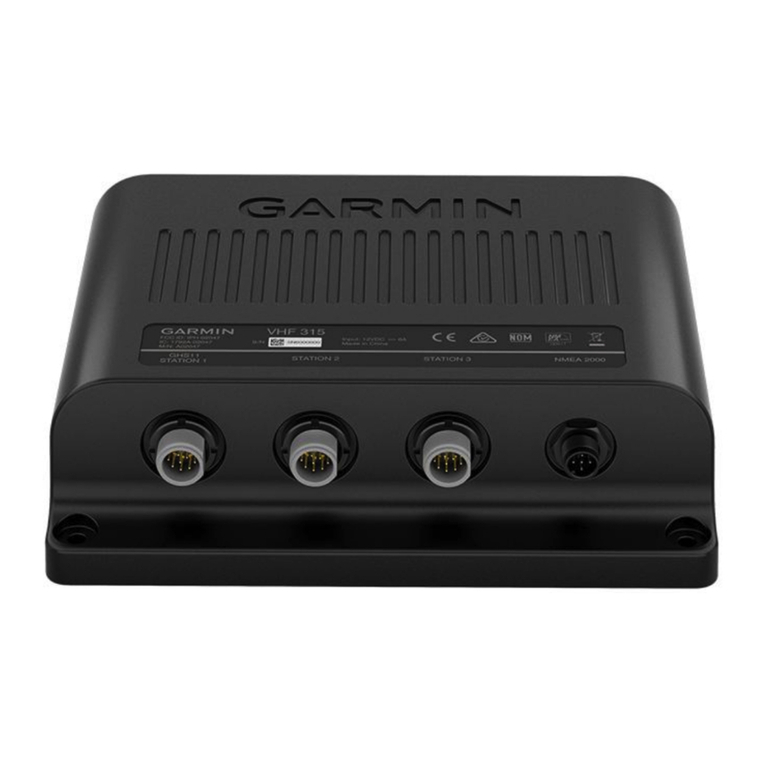
Garmin
Garmin VHF 315 Series installation instructions
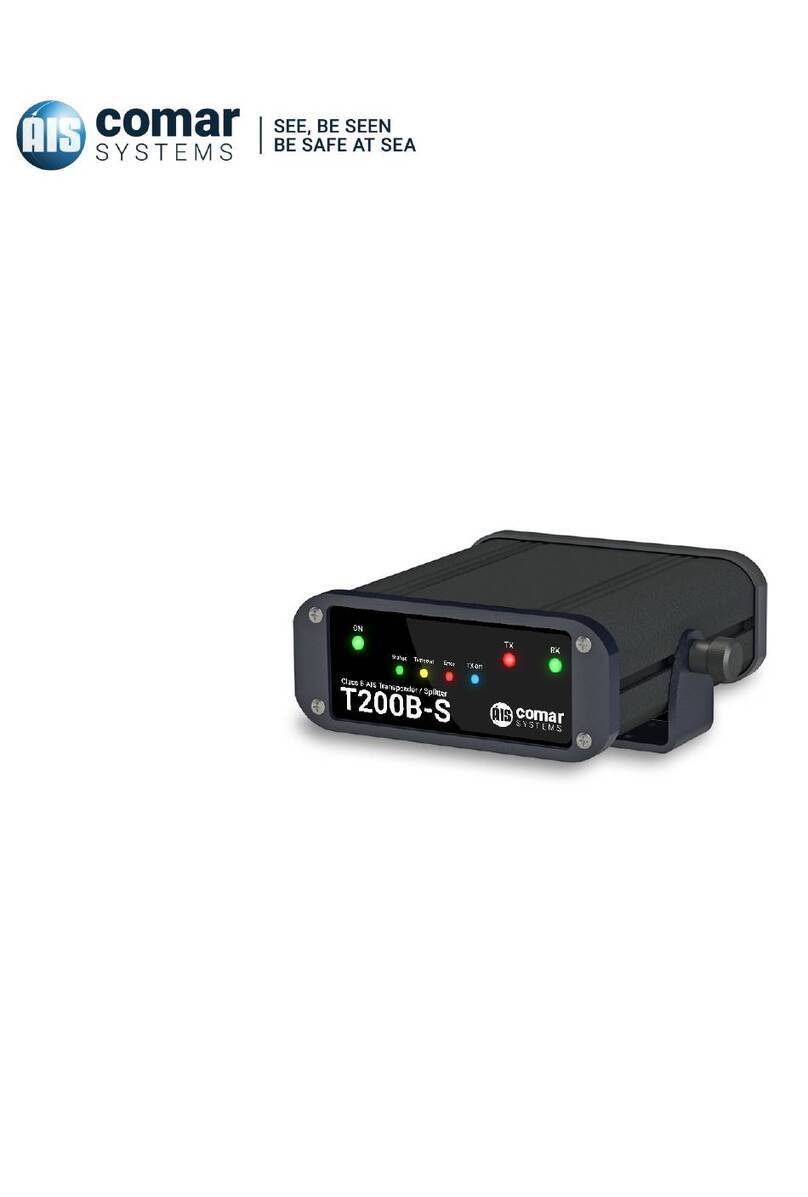
Comar Systems
Comar Systems T200B-S user manual
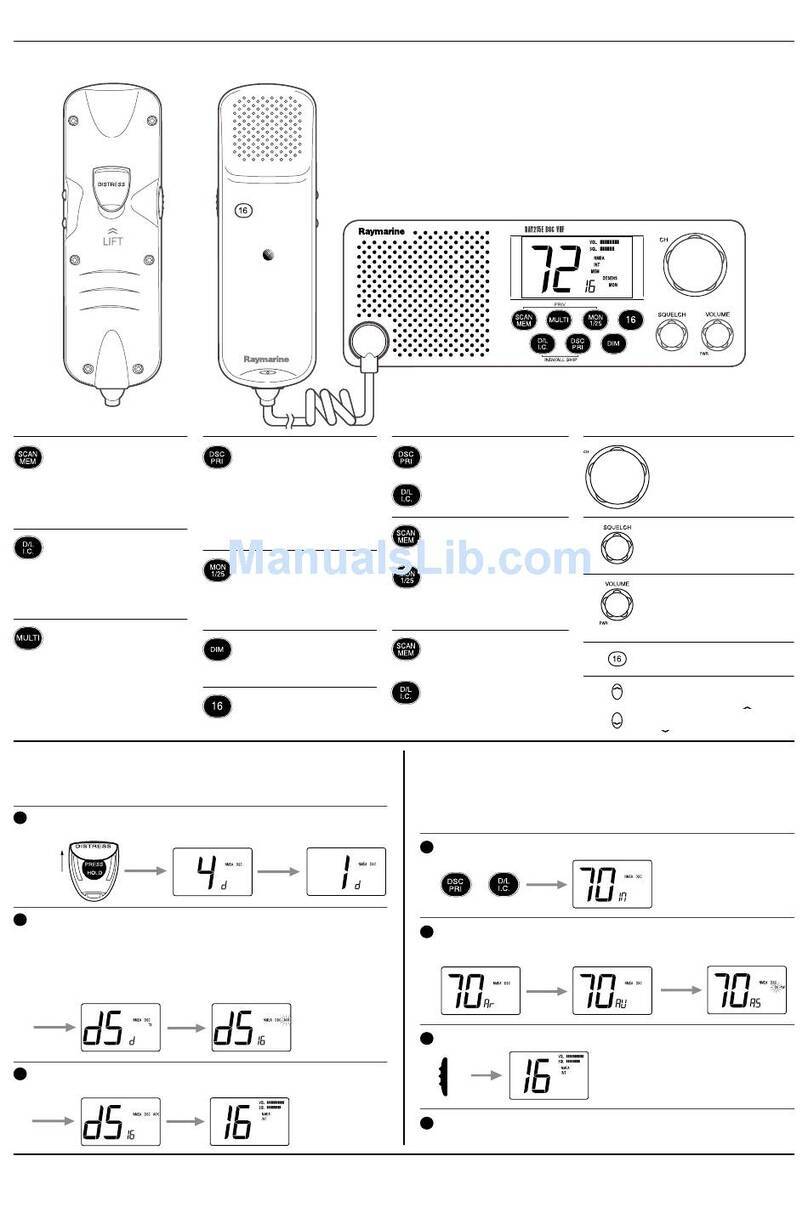
Raymarine
Raymarine Ray215e quick reference
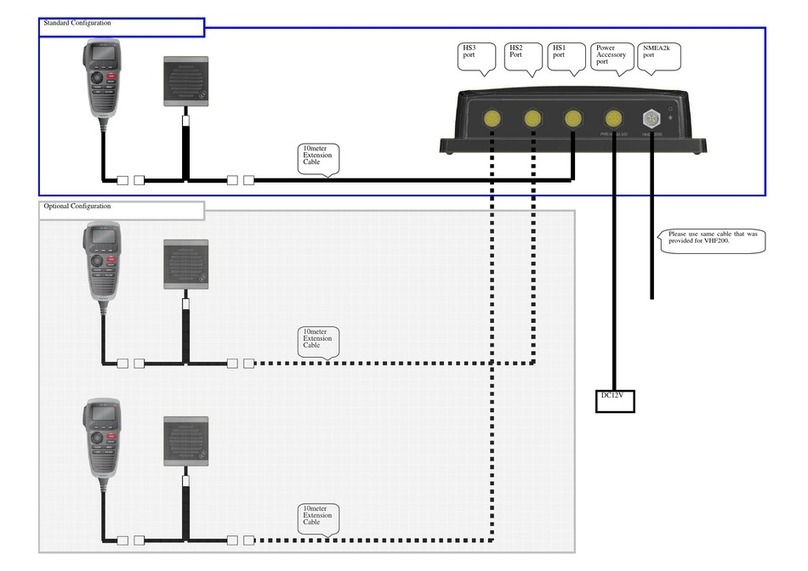
Garmin
Garmin VHF 300 - Marine Radio instruction manual
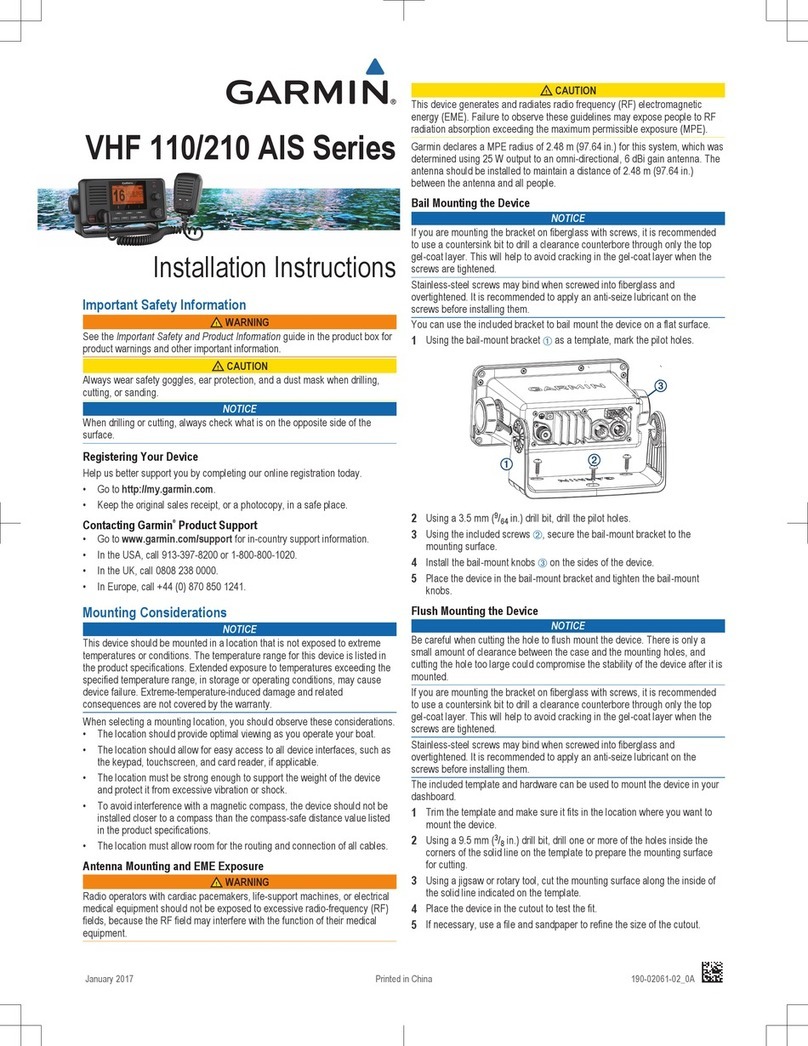
Garmin
Garmin VHF 110 AIS series installation instructions
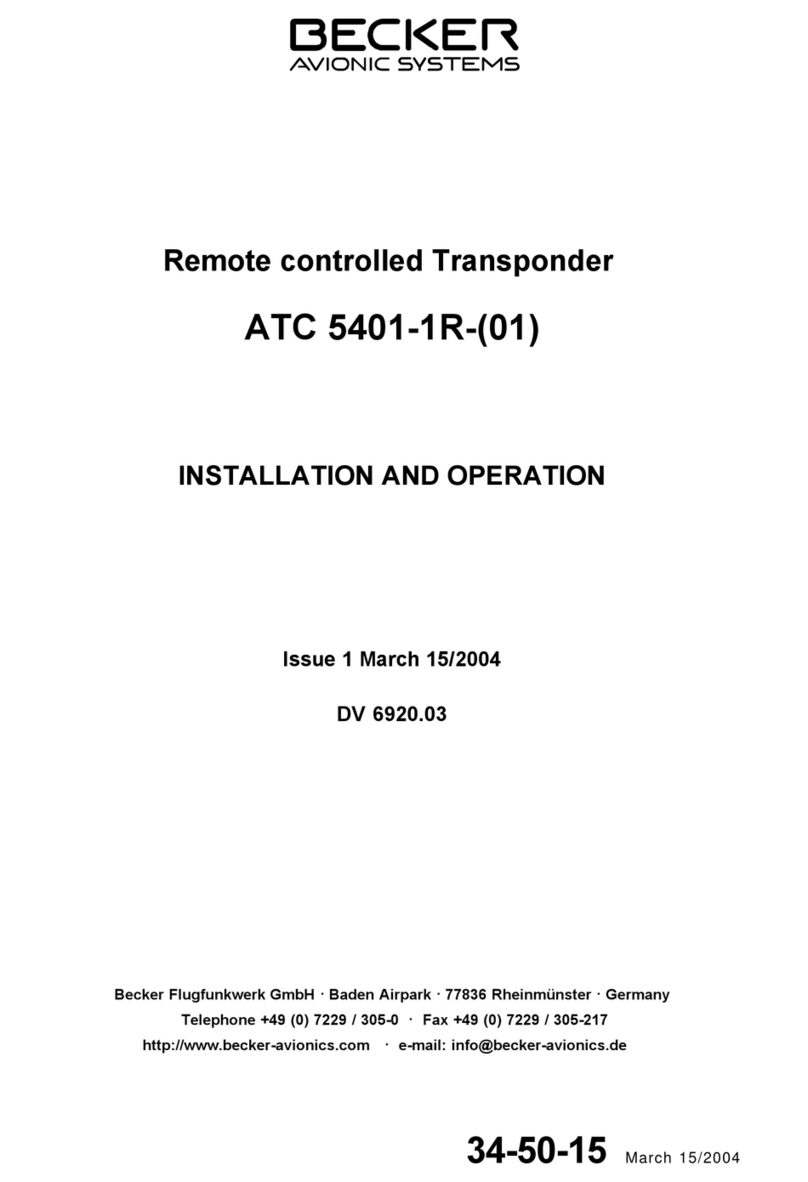
Becker
Becker ATC 5401-1R-01 Installation & operation

